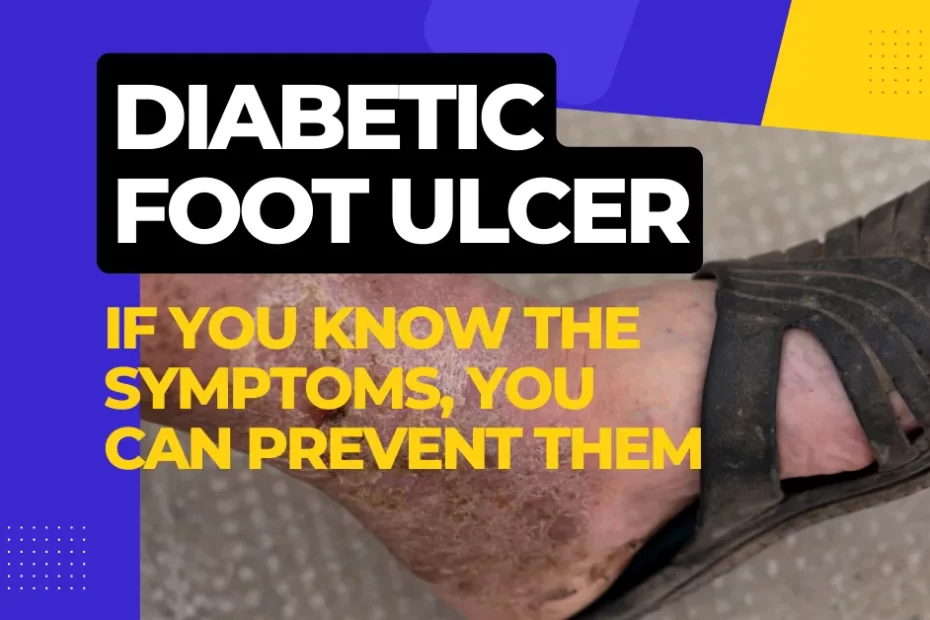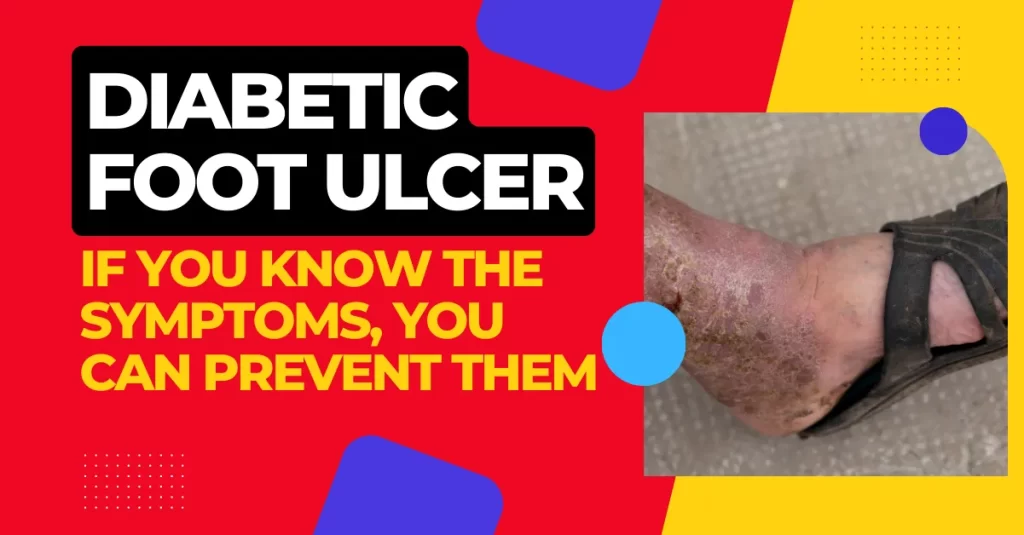Diabetes can lead to several complications, including foot ulcers. These ulcers can develop when damage occurs to the nerves or blood vessels in the feet, leading to poor circulation, numbness, and a decreased ability to heal.
Type 2 diabetes is a chronic condition characterized primarily by unstable blood sugar levels, resulting in the production of insufficient insulin or an inadequate insulin response, which leads to elevated blood sugar levels.
Usually, insulin helps regulate blood sugar levels – the primary type of sugar (glucose) found in the blood. However, without proper regulation, blood sugar levels can rise too high, leading to symptoms such as frequent urination, blurred vision, increased thirst and hunger, fatigue, weight loss, numbness, and tingling in the hands and feet.
- Many of the signs that blood sugar levels are running high can appear in your feet.
- Early detection of any skin lesions (such as blisters) could help prevent them from becoming serious medical issues.
- It’s essential to keep an eye out for signs of skin infections in your feet because they may develop into severe conditions if not treated promptly. Several factors can cause foot pain.
Warning Signs of Diabetic Foot Ulcers
People living with diabetes need to pay close attention to their feet. Poor blood sugar control can damage circulation and nerves, making the feet more vulnerable to injuries and infections. One of the most serious complications is the development of diabetic foot ulcers. These open sores or wounds can appear on the toes, soles, or sides of the feet and may become infected if not treated quickly. Recognizing the early signs is essential for preventing serious complications, including hospitalizations or even amputation.
Below is a simple table that explains the most common warning signs of diabetic foot ulcers, their causes, and why you should take them seriously. If you notice any of these changes, consult a healthcare professional immediately.
| Warning Sign | Description | Why It Matters |
|---|---|---|
| Changes in skin color or temperature | If your feet are often cold, or if they turn bluish, reddish, or pale, it may indicate poor circulation. | Poor circulation increases the risk of ulcers, infections, and delayed healing. |
| Numbness or tingling | Feeling numbness, burning, or tingling in your feet is a sign of nerve damage (neuropathy). | Loss of sensation makes it difficult to detect cuts, blisters, or pressure that can turn into ulcers. |
| Swelling | Swelling in the feet or ankles may be linked to poor circulation, infection, or fluid retention. | Untreated swelling can lead to infections and increase ulcer risks. |
| Pain or tenderness | Any ongoing pain, soreness, or tenderness in the feet or toes should not be ignored. | Pain may indicate infection, injury, or the beginning of a foot ulcer that needs medical attention. |
| Calluses or corns | Areas of thickened skin caused by friction or pressure can break down over time. | If untreated, calluses and corns can develop into painful ulcers and infections. |
| Ingrown toenails | When the nail grows into the skin, it can cause pain, swelling, and infection. | An untreated ingrown toenail can easily turn into an ulcer or lead to serious infection. |
Taking care of your feet daily is the best way to prevent problems. Always check for cuts, blisters, or changes in skin, wash and dry your feet carefully, and wear comfortable shoes. Most importantly, schedule regular checkups with your doctor or podiatrist. By staying alert to the warning signs of diabetic foot ulcers, you can protect your health, prevent complications, and maintain your mobility.
Essential Steps for Diabetic Foot Ulcer Prevention
Living with diabetes requires special care, especially when it comes to protecting your feet. High blood sugar levels can damage nerves and reduce blood circulation, making the feet more vulnerable to injuries and infections. Over time, even small cuts or blisters can turn into serious foot ulcers if not managed properly. The good news is that by following simple steps every day, you can significantly lower your risk of developing complications. Here are the essential steps for diabetic foot ulcer prevention explained in a clear and practical way.
| Step | Description |
|---|---|
| 1. Keep Blood Sugar Levels Under Control | One of the most important things you can do to prevent foot ulcers is to maintain healthy blood sugar levels. Balanced glucose levels reduce the risk of nerve damage and poor circulation. You can achieve this through a combination of prescribed medication, a healthy eating plan rich in whole foods, and regular physical activity such as walking or swimming. |
| 2. Check Your Feet Daily | Make it a habit to check your feet every day for redness, swelling, blisters, cuts, or signs of infection. Use a mirror to look at the bottom of your feet, or ask a family member for help if needed. Early detection of problems is key to diabetic foot ulcer prevention. |
| 3. Wear Proper Footwear | Shoes and socks should fit comfortably and provide support. Avoid tight shoes, high heels, or pointed-toe footwear that create pressure points. Soft, cushioned shoes paired with moisture-wicking socks help protect the feet and reduce friction. This simple step can significantly lower the risk of ulcers. |
| 4. Keep Your Feet Clean and Dry | Wash your feet daily with warm (not hot) water and mild soap. Dry them carefully with a soft towel, paying special attention to the spaces between your toes. Moisturize your heels and soles to prevent dryness, but avoid putting lotion between your toes, as excess moisture can encourage fungal infections. |
| 5. Trim Toenails Carefully | Cut your toenails straight across to avoid ingrown nails, and smooth sharp edges with a nail file. Never cut them too short, as this increases the risk of injury and infection. Regular nail care is an important part of healthy foot care for diabetics. |
| 6. Don’t Smoke | Smoking narrows blood vessels and reduces circulation, making it harder for wounds to heal. If you smoke, quitting can dramatically improve blood flow to your feet and help in preventing foot ulcers. |
| 7. See a Healthcare Professional Regularly | Regular check-ups with a podiatrist or healthcare provider are crucial. They can identify problems early and provide treatment before they develop into serious complications. Professional care combined with daily self-care is the best approach to long-term foot health in diabetes. |
By following these steps consistently, you can reduce the risk of painful complications and maintain independence. Remember, prevention is always better than cure. Taking proactive measures now will help you enjoy the many benefits of healthy living while keeping your feet safe and strong.
Share this:
- Click to share on Facebook (Opens in new window) Facebook
- Click to share on Pinterest (Opens in new window) Pinterest
- Click to share on LinkedIn (Opens in new window) LinkedIn
- Click to share on X (Opens in new window) X
- Click to share on Tumblr (Opens in new window) Tumblr
- Click to share on Bluesky (Opens in new window) Bluesky


A balanced life is possible. just take care
Foot ulcers are open sores or wounds that occur on the feet. They are commonly caused by poor circulation, nerve damage, pressure on specific areas of the foot, or a combination of these factors. People with diabetes are particularly at risk for developing foot ulcers due to complications related to the disease.
Great tips! It’s so important for those with diabetes to regularly check their feet for any signs of irritation or injury.
Swordfish is a great source of lean protein and healthy fats. This makes it an excellent choice for people with diabetes or those looking to manage their weight.